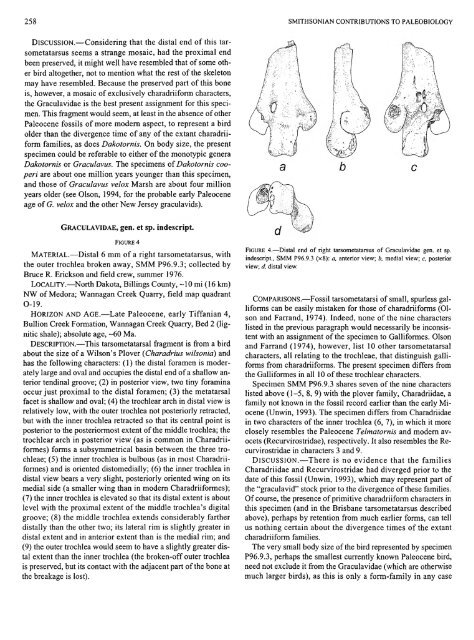PDF (Lo-Res) - Smithsonian Institution Libraries
PDF (Lo-Res) - Smithsonian Institution Libraries
PDF (Lo-Res) - Smithsonian Institution Libraries
Create successful ePaper yourself
Turn your PDF publications into a flip-book with our unique Google optimized e-Paper software.
258<br />
DISCUSSION.—Considering that the distal end of this tarsometatarsus<br />
seems a strange mosaic, had the proximal end<br />
been preserved, it might well have resembled that of some other<br />
bird altogether, not to mention what the rest of the skeleton<br />
may have resembled. Because the preserved part of this bone<br />
is, however, a mosaic of exclusively charadriiform characters,<br />
the Graculavidae is the best present assignment for this specimen.<br />
This fragment would seem, at least in the absence of other<br />
Paleocene fossils of more modem aspect, to represent a bird<br />
older than the divergence time of any of the extant charadriiform<br />
families, as does Dakotornis. On body size, the present<br />
specimen could be referable to either of the monotypic genera<br />
Dakotornis or Graculavus. The specimens of Dakotornis cooperi<br />
are about one million years younger than this specimen,<br />
and those of Graculavus velox Marsh are about four million<br />
years older (see Olson, 1994, for the probable early Paleocene<br />
age of G. velox and the other New Jersey graculavids).<br />
GRACULAVIDAE, gen. et sp. indescript.<br />
FIGURE 4<br />
MATERIAL.—Distal 6 mm of a right tarsometatarsus, with<br />
the outer trochlea broken away, SMM P96.9.3; collected by<br />
Bmce R. Erickson and field crew, summer 1976.<br />
LOCALITY.—North Dakota, Billings County, -10 mi (16 km)<br />
NW of Medora; Wannagan Creek Quarry, field map quadrant<br />
0-19.<br />
HORIZON AND AGE.—Late Paleocene, early Tiffanian 4,<br />
Bullion Creek Formation, Wannagan Creek Quarry, Bed 2 (lignitic<br />
shale); absolute age, -60 Ma.<br />
DESCRIPTION.—This tarsometatarsal fragment is from a bird<br />
about the size of a Wilson's Plover {Charadrius wilsonia) and<br />
has the following characters: (1) the distal foramen is moderately<br />
large and oval and occupies the distal end of a shallow anterior<br />
tendinal groove; (2) in posterior view, two tiny foramina<br />
occur just proximal to the distal foramen; (3) the metatarsal<br />
facet is shallow and oval; (4) the trochlear arch in distal view is<br />
relatively low, with the outer trochlea not posteriorly retracted,<br />
but with the inner trochlea retracted so that its central point is<br />
posterior to the posteriormost extent of the middle trochlea; the<br />
trochlear arch in posterior view (as is common in Charadriiformes)<br />
forms a subsymmetrical basin between the three trochleae;<br />
(5) the inner trochlea is bulbous (as in most Charadriiformes)<br />
and is oriented distomedially; (6) the inner trochlea in<br />
distal view bears a very slight, posteriorly oriented wing on its<br />
medial side (a smaller wing than in modem Charadriiformes);<br />
(7) the inner trochlea is elevated so that its distal extent is about<br />
level with the proximal extent of the middle trochlea's digital<br />
groove; (8) the middle trochlea extends considerably farther<br />
distally than the other two; its lateral rim is slightly greater in<br />
distal extent and in anterior extent than is the medial rim; and<br />
(9) the outer trochlea would seem to have a slightly greater distal<br />
extent than the inner trochlea (the broken-off outer trochlea<br />
is preserved, but its contact with the adjacent part of the bone at<br />
the breakage is lost).<br />
SMITHSONIAN CONTRIBUTIONS TO PALEOBIOLOGY<br />
FIGURE 4.—Distal end of right tarsometatarsus of Graculavidae gen. et sp.<br />
indescript., SMM P96.9.3 (x8): a, anterior view; b, medial view; c, posterior<br />
view; d, distal view.<br />
COMPARISONS.—Fossil tarsometatarsi of small, spurless galliforms<br />
can be easily mistaken for those of charadriiforms (Olson<br />
and Farrand, 1974). Indeed, none of the nine characters<br />
listed in the previous paragraph would necessarily be inconsistent<br />
with an assignment of the specimen to Galliformes. Olson<br />
and Farrand (1974), however, list 10 other tarsometatarsal<br />
characters, all relating to the trochleae, that distinguish galliforms<br />
from charadriiforms. The present specimen differs from<br />
the Galliformes in all 10 of these trochlear characters.<br />
Specimen SMM P96.9.3 shares seven of the nine characters<br />
listed above (1-5, 8, 9) with the plover family, Charadriidae, a<br />
family not known in the fossil record earlier than the early Miocene<br />
(Unwin, 1993). The specimen differs from Charadriidae<br />
in two characters of the inner trochlea (6, 7), in which it more<br />
closely resembles the Paleocene Telmatomis and modem avocets<br />
(Recurvirostridae), respectively. It also resembles the Recurvirostridae<br />
in characters 3 and 9.<br />
DISCUSSION.—There is no evidence that the families<br />
Charadriidae and Recurvirostridae had diverged prior to the<br />
date of this fossil (Unwin, 1993), which may represent part of<br />
the "graculavid" stock prior to the divergence of these families.<br />
Of course, the presence of primitive charadriiform characters in<br />
this specimen (and in the Brisbane tarsometatarsus described<br />
above), perhaps by retention from much earlier forms, can tell<br />
us nothing certain about the divergence times of the extant<br />
charadriiform families.<br />
The very small body size of the bird represented by specimen<br />
P96.9.3, perhaps the smallest currently known Paleocene bird,<br />
need not exclude it from the Graculavidae (which are otherwise<br />
much larger birds), as this is only a form-family in any case

















